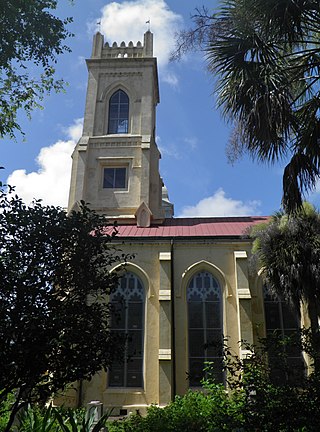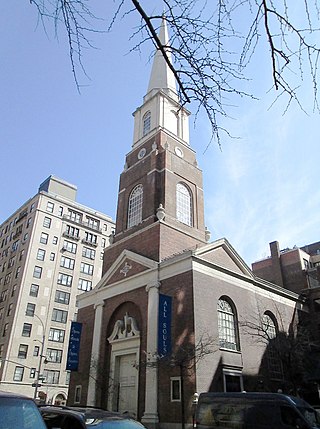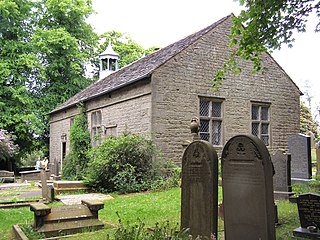
The Cobble Hill Tunnel is an abandoned Long Island Rail Road (LIRR) tunnel beneath Atlantic Avenue in Brooklyn, New York City, running through the neighborhoods of Downtown Brooklyn and Cobble Hill. When open, it ran for about 2,517 feet (767 m) between Columbia Street and Boerum Place. It is the oldest railway tunnel beneath a city street in North America that was fully devoted to rail. It is also deemed the oldest subway tunnel in the world by the Guinness Book of World Records.

Carroll Gardens is a neighborhood in the northwestern portion of the New York City borough of Brooklyn. Taking up around 40 city blocks, it is bounded by Degraw and Warren Streets (north), Hoyt and Smith Streets (east), Ninth Street or the Gowanus Expressway (south), and Interstate 278, the Gowanus and Brooklyn–Queens Expressways (west). The neighborhoods that surround it are Cobble Hill to the northwest, Boerum Hill to the northeast, Gowanus to the east, Red Hook to the south and southwest, and the Columbia Street Waterfront District to the west.

The First Unitarian Society of Madison (FUS) is a Unitarian Universalist congregation in Shorewood Hills, Wisconsin. Its meeting house was designed by Frank Lloyd Wright and built by Marshall Erdman in 1949–1951, and has been designated a U.S. National Historic Landmark for its architecture. With over 1,000 members, it is one of the ten largest Unitarian Universalist congregations in the United States.

Jacob Wrey Mould was a British architect, illustrator, linguist and musician, noted for his contributions to the design and construction of New York City's Central Park. He was "instrumental" in bringing the British High Victorian style of architecture to the United States, and was a founding member of the American Institute of Architects.

The Unitarian Church in Charleston, home to a Unitarian Universalist congregation, is an historic church located at 4 Archdale Street in Charleston, South Carolina. It is the oldest Unitarian church in the South and the second oldest church building on the peninsula of Charleston.

The Unitarian Church of All Souls at 1157 Lexington Avenue at East 80th Street in the Upper East Side of Manhattan, New York City was built in 1932 and was designed by Hobart Upjohn – Richard Upjohn's grandson – in the Neo-colonial style with a Regency-influenced brick base. It is the congregation's fourth sanctuary. The congregation, dating back to 1819, was the first Unitarian Universalist congregation in the city. It has provided a pulpit for some of the movement's leading theologians and has also recorded many eminent persons in its membership.

First Unitarian Church is a historic congregation of the Unitarian Universalist Association in Cincinnati, Ohio, United States. Founded in the early nineteenth century, it survived a series of division and reunifications in the nineteenth century. Among the people who have worshipped in its historic church building on the city's northern side are many members of the Taft family, including William Howard Taft, the President of the United States.

First Unitarian Congregational Society in Brooklyn is a Unitarian Universalist congregation in Brooklyn, NY. The Society was established in 1833 and has been worshiping in its historic Gothic Revival Sanctuary since 1844. The Sanctuary is adorned with stained glass windows and a Louis C. Tiffany angel mosaic. It is one of the earliest Unitarian congregations in the United States, established just 8 years after the American Unitarian Association was formed in 1825.

The First Baptist Church is a historic American Baptist Churches USA congregation, established in 1665. It is one of the oldest Baptist churches in the United States. It first met secretly in members homes, and the doors of the first church were nailed shut by a decree from the Puritans in March 1680. The church was forced to move to Noddle's Island. The church was forced to be disguised as a tavern and members traveled by water to worship. Rev. Dr. Stillman led the church in the North End for over 40 years, from 1764 to 1807. The church moved to Beacon Hill in 1854, where it was the tallest steeple in the city. After a slow demise under Rev. Dr. Rollin Heber Neale, the church briefly joined with the Shawmut Ave. Church, and the Warren Avenue Tabernacle, and merged and bought the current church in 1881, for $100,000.00. Since 1882 it has been located at the corner of Commonwealth Avenue and Clarendon Street in the Back Bay. The interior is currently a pending Boston Landmark through the Boston Landmarks Commission.

The former First Unitarian Church is a historic church building at 130 Highland Avenue in Somerville, Massachusetts. The stone church was built in 1894 for a Unitarian congregation. It was designed by Hartwell & Richardson and is a good example of Richardsonian Romanesque design. The building presently (2022) houses the Mission Church of Our Lord Jesus Christ.

The Unitarian Society was a historic church building located in Fall River, Massachusetts.

Emmanuel Baptist Church is a Baptist megachurch in the Clinton Hill neighborhood of Brooklyn, New York, on the northwest corner of Lafayette Avenue and St. James Place, affiliated with the American Baptist Churches USA. The attendance is 2,200 peoples. The senior pastor is Anthony L. Trufant.

Rivington Unitarian Chapel is an active place of Unitarian worship in Rivington, Lancashire, England. It was founded in 1703, although its congregation dates to 1667. It is designated as a Grade II* listed building with some restoration in 1990, and hs ongoing preservation.

The Second Congregational Church in New York, organized in 1825, was a Unitarian congregation which had three permanent homes in Manhattan, New York City, the second of which became a theater after they left it. In 1919 the congregation joined the Community Church Movement and changed its name to Community Church of New York. The same year its church, on 34th Street, was damaged by fire. Since 1948 the congregation has been located at 40 East 35th Street. It is currently part of the Unitarian Universalist Association.

Unitarian Universalist Church of Arlington (UUCA), historically known as the Unitarian Church of Arlington, is a Unitarian Universalist church located at 4444 Arlington Boulevard in Arlington County, Virginia. Founded in 1948, UUCA was the first Unitarian church in Washington, D.C.'s suburbs. Throughout its history, UUCA has taken part in progressive causes from the Civil Rights Movement to the legalization of same-sex marriage in Virginia. During the Civil Rights Movement, UUCA was the only Virginia church to speak out in favor of racial integration. UUCA's sanctuary building, designed by local architect Charles M. Goodman in 1964, is a concrete Brutalist structure that was listed on the National Register of Historic Places and Virginia Landmarks Register in 2014. It is one of only three church buildings designed by Goodman and the only one in Virginia.

Congregation Kesher Israel is a synagogue located in the Society Hill section of Center City Philadelphia. The synagogue is home to an active congregation with Shabbat and holy day services, a Hebrew school, adult education, and community programming. It is affiliated with the conservative movement.

Celia M. Burleigh was an American minister, writer, public speaker, and women's rights activist. She was involved with the woman's club movement and held various positions in women's rights clubs.

The Concert Grove is a section of Prospect Park, Brooklyn, New York City, that historically functioned as an outdoor music venue. It still serves as a sculpture garden lined with busts of musical figures, largely put up by German American Sängerfest participants and other cultural groups. The Concert Grove also includes the Concert Grove Pavilion, formerly known as the Oriental Pavilion, and adjoins a Lincoln sculpture facing the lake.

Theodore Parker Unitarian Universalist Church is a historic church building at 1859 Centre Street in the West Roxbury neighborhood of Boston, Massachusetts. Built in 1900 to a design by West Roxbury native Henry M. Seaver, it is a locally significant example of Normanesque architecture, and is adorned by stained glass windows created by Louis Comfort Tiffany and his firm. The church was listed on the National Register of Historic Places in 2020. The congregation it houses was founded in 1712, and is named for the influential Transcendentalist and abolitionist Theodore Parker, who was the congregation's minister in the 1840s.



















